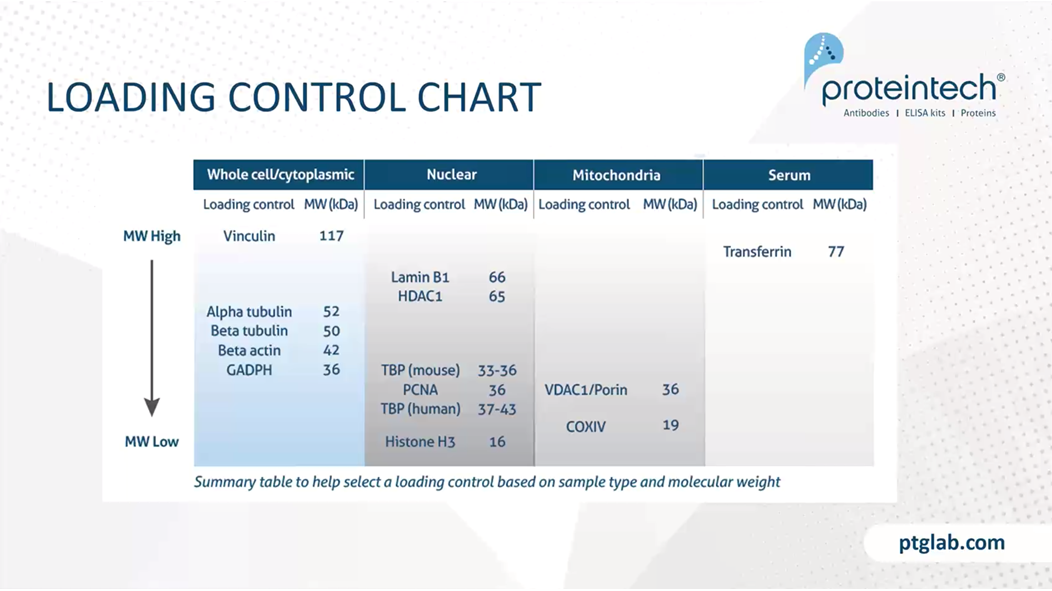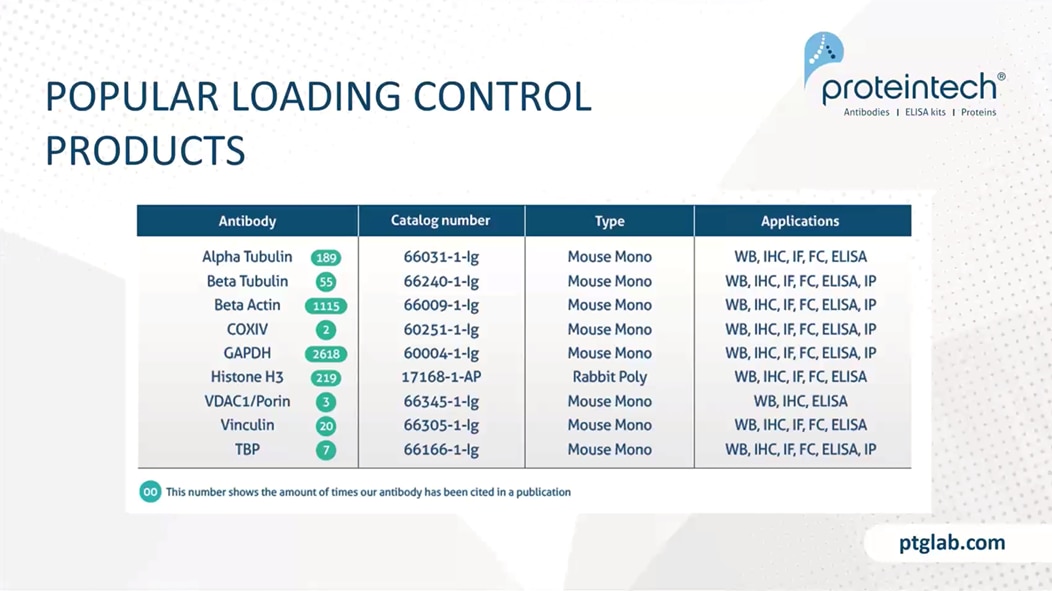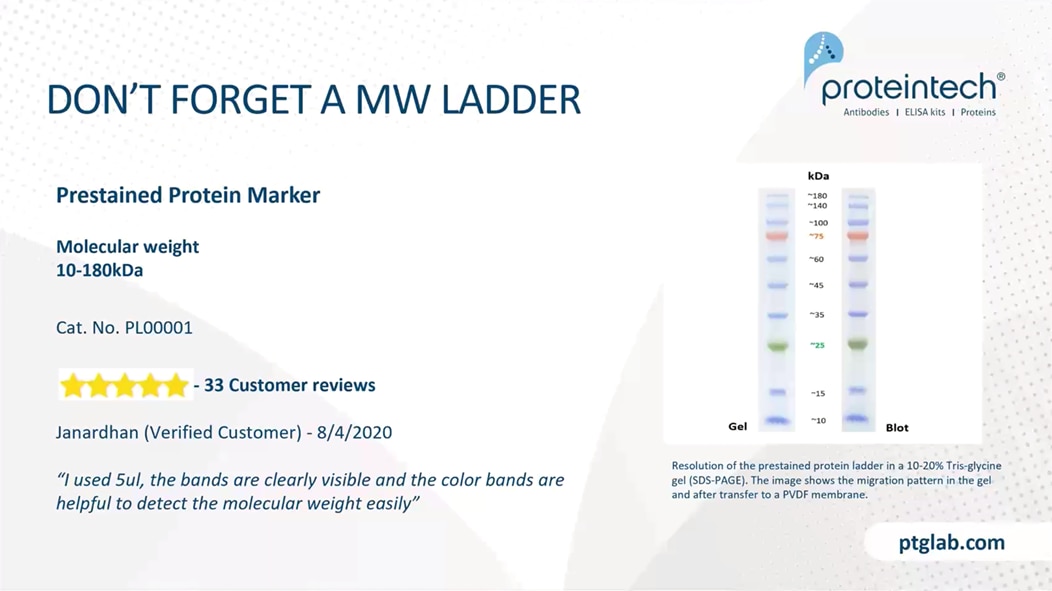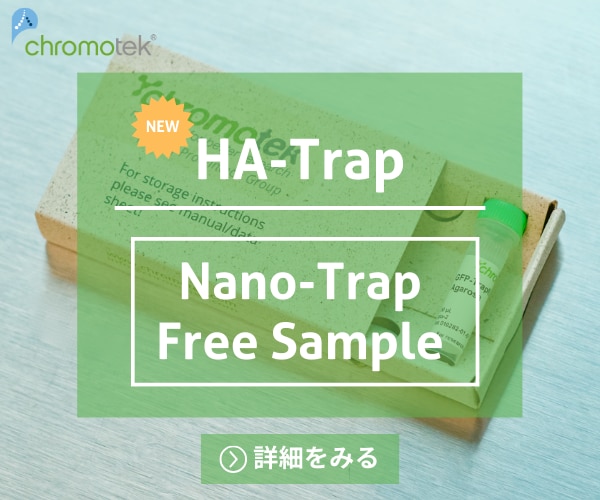Understanding Your Controls for Western Blotting
Understanding Your Controls for Western Blotting
In this webinar, we're going to understand why you run controls, what are the considerations when choosing controls, going through some of the popular controls, and finally ending your experiments with protein ladders.
Video Transcription
Welcome everybody to this webinar on Understanding Your Controls for Western Blotting. My name is Will Olds. I'm the scientific officer for Proteintech Group. I've been working on a lot of the technical content for the last five years, and I'm very excited today, to tell you more about how to use controls and which controls are best for your particular experiments.
So, in terms of our agenda today, what we're going to work on is why do you run controls in the first place, some considerations when choosing controls, going through a few popular controls, and then ending with protein ladders, one final control that you need in your experiments.
Introduction to Proteintech
So, for those of you who are not familiar with Proteintech, I just wanted to give a short intro here. So, at Proteintech, one of the major things that we do is all of our products are manufactured and validated in-house, so that gives us a lot of quality control, as well as to be able to really know everything about the antibody that you're purchasing.
We recently received ISO certification, which just means that we have a process in place for keeping things at a very high quality and reproducibility, and it also allows us to sell GMP-grade products. We have five sites globally with full product inventory. Our products have been cited over 70,000 times in publications worldwide.
And we also love to support the scientific community with mentorship awards, travel grants, workshops, and more to help you guys become the 70,001st publication.
Our slogan is, "From our bench to your bench," and so, what do we mean by that? So, in terms of how the antibody industry is now, we have a bunch of different manufacturers, as denoted here, and they sell to resellers. And sometimes the resellers sell that stuff to you, or they sell between themselves, or they sell it to other manufacturers. So, what this means is that to you, the customer, you might be getting an antibody from A, B, C, and D, but they could all be coming from manufacturer A, for instance. But they're relabeled and sent in such a way that you don't really know beforehand that you bought four vials of the same exact thing.
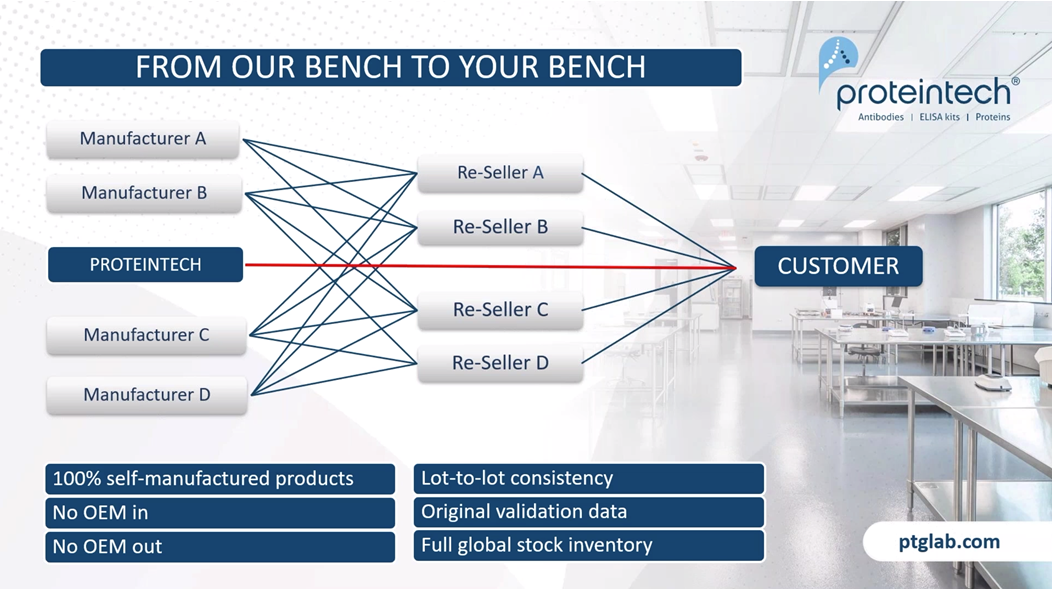
So, at Proteintech, we sell only our stuff, and we sell it directly to you. And so, you don't have to worry about this kind of a web of purchases in between these different vendors. Everything that we make is straight from ourselves, and it is completely unique. And so, in addition, as I said before, this gives us a little bit more lot-to-lot consistency because reseller D may get it from manufacturer D now, but they may get it from manufacturer C later. And so, the consistency may not be the same to you. And as well as being able to provide all of our original validation data, including our raw films, and we have great stock inventory as a result of being able to control everything.
So, a little bit more about our products. We have antibodies against 13,000 human targets. We have 2,500 targets that have validated by knockout or knocked down validation. We have more than 200 ELISA kits available. We also sell a line of HumanKine, human cell-expressed cytokines, and growth factors for use in cell and gene therapies. Our CoraLite brand of fluorescent-dye conjugated antibodies, neutralizing antibodies, and prestained protein markers/ladders.
And so, for us, it's really about helping you guys, and so we really love to celebrate the success our scientists have had, and we're very proud of the great discoveries they've made. So, below here, you can see some cover stories of studies that have used our antibodies, and we've been cited over 70,000 times in publications worldwide. And you can see this graph that's got a steep slope, so we're really excited to see that we're making a big impact in helping you guys make the next great discovery.
1. Why run controls?
So, now, let's get to the meat and potatoes of this. Why are controls in antibody application so important? So, first of all, it ensures that your results are biologically real. Otherwise, there may be artifacts, background signal that make it challenging to understand whether this is a real sample or not. And as well as minimize the variables that may be due to human error or environmental changes or what-have-you. It also allows you to compare data with your results, other lab members, as well as published data.
So, these are more broader reasons for why controls are needed. Let's go into western blotting specifically. So, let's say you did an awesome experiment here using HeLa cells and you're looking at this protein, LDHB, and you're just validating and make sure it works. So, you have two sets of cells, one set of HeLa cells that you transfected with a siRNA scramble here, and then, there's one where you used siRNA directed towards LDHB. And so, as expected, when you add the LDHB siRNA in there, it decreases the amount of signal in there, denoting that this antibody is specific. And so, you try to send this for manuscript review, they're not going to be very happy with you, because you don't know whether it worked.
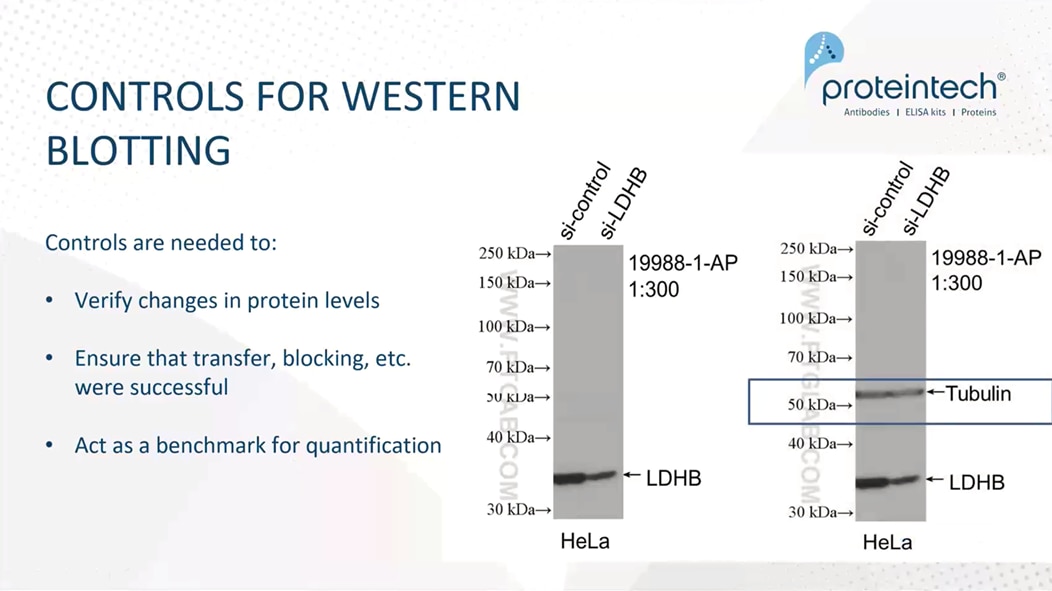
One reason why this signal is low, why this is less intense, is maybe because the siRNA worked, but it could be that your transfer was not complete for whatever reason, for that lane. It may mean that you didn't load as much protein for whatever reason in that one. And then, later, if you want to quantify, you can't really say if this one's really much lower than this one, because there's no benchmark that's used. And so, that's why you need something like tubulin in this case. And so, as you can see here, this tubulin is the same between both lanes, and so that means the same protein was loaded, the WB was right, the blocking, everything worked out just as you expected. And so, therefore, if you compare the signal compared to tubulin here, and then compared to tubulin here, you can see that there was a significant drop off here. And so, therefore, you can say if the siRNA had an effect on this target.
So, what makes a good control? So, a great control is a ruler, a benchmark, something that should not change despite the other variables in your experiment changing. It needs to be something that's ubiquitous, something that you can use throughout your experiments and not have to change or swap out things that frequently. It needs to be something that's highly expressed, and it needs to be an essential gene that's not affected by maybe cellular changes. And so, for the most part, these are structural and metabolic proteins.
On the right here, we have a Western blotting GAPDH, which is one of the favorite proteins that people use for their loading controls, and this one's really excellent in that it can be used for all the way from zebrafish to HeLa and heart, and I think some people even use this in yeast, as well. So, it's a really wonderful control.
2. Considerations when choosing controls
So, when choosing a control, you don't just pick from a bag and say, "I'm going to pick GAPDH today or Beta-Actin this time." You need to ask yourself a couple of questions. So, the first one is just, does the experiment affect the control in any way? If it's changing GAPDH levels, then GAPDH is not going to be a great control for you.
It's also important to check out the literature for your specific field. There could be controls that people like to use for that particular thing, and it's best to follow the convention of your colleagues in that field.
Additionally, if you're analyzing organelle fractions, it's important to choose one that's specific for that organelle. So, again, if you use GAPDH, which is in the cytosol, and you're looking at a nuclear fraction, you're not going to get any signal and it will not be able to control.
The last consideration is how close in molecular weight is the control to my favorite protein that's being analyzed. So, for instance, GAPDH is 37K, and so a 30 to 40kDa protein is not a good choice. And also, Beta-Actin has a circadian variations, so for certain experiments where you're looking at circadian rhythms, it's not the best control to use.
So, here's a handy chart for all of your loading controls, and so it's listed here from high molecular weight to low molecular weight. So, you have the all-stars that we all know and love here, but if you're looking at a high molecular weight protein, Vinculin's really great for the whole cell. And then if you're looking at nuclear proteins, here are some great ones, like Lamin, HDAC1, Histone H3. And then for mitochondria, there are also some other ones there, for COXIV for little bit lower, VDAC for more your mid-range. And for serum samples, transferrin is a really great loading control.
So I'm going to highlight a couple of these products here that we provide. The first one I want to highlight here is Beta-Actin, a mouse monoclonal antibody. And on the left here is a serial dilution using the same samples and with progressing dilutions of antibody. So, for this first one, this is using this product here from one to 40,000 and all the way down to signal that you can see at one to 640,000. We then compare this in the same experiments to ones from other companies that provide this, and as you can see here, the signal drops off precipitously as you do this. And the Proteintech one is quite a superior. So, it's max dilution is about one to 640,000, so it's almost like one vial is a lifetime supply. And for the competitors, it seems like for this one is one to 320,000, and this one's one to 80,000.
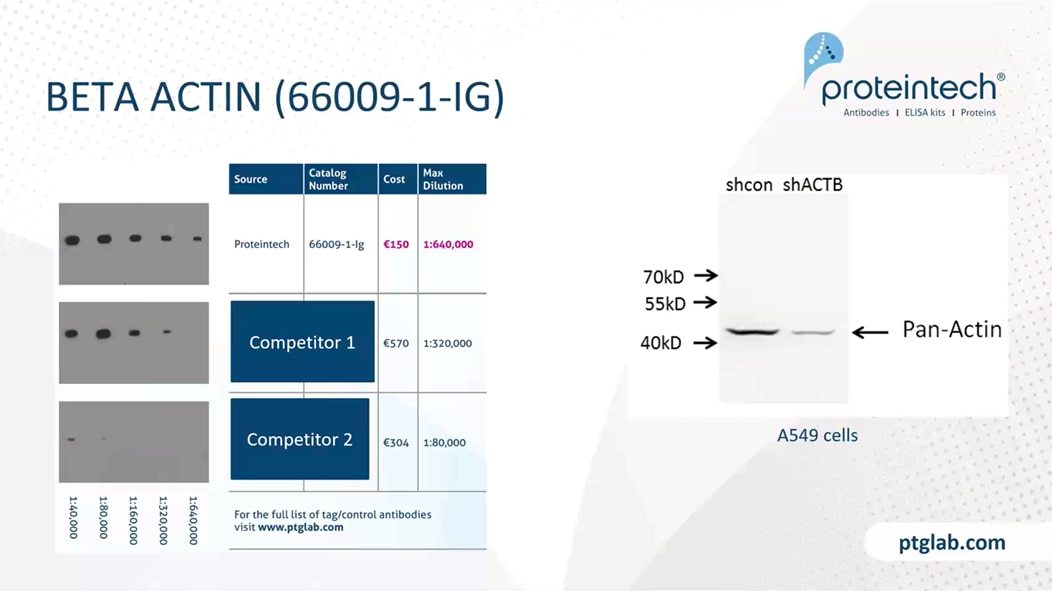
But the main thing I want to keep back here is that you're getting a lot of bang for your buck here. The cost is much lower here, so it's about $99 in the US and about 150 euros. At this moment, you can see how this is much cheaper than the competitors. Over here is just an siRNA experiment showing that this is a specific antibody towards this target.
So, the next one I want to highlight is GAPDH. We did a very similar experiment with serial dilution and just see when the signal goes out. And so, this one, we were able to go up to one to 1.2 million, and it looks like one of our competitors was also able to go to that same level. However, this other one did not perform quite as well. And so, again, this one has similar performance between these two, but this one's, again, much, much cheaper. So, this is a real bargain for what you get out of it. And on the right here is the same western blot I was showing before that, for this particular antibody, showing that it just works across a variety of cell lines and tissue types.
The last one I just want to highlight here is Vinculin. So, this is about 110 kDa, and this one is really excellent for high molecular weight markers and works across a variety of cell lines, as you can see here.
So, when you go to any website looking for these targets, you're going to see a monoclonal and polyclonal options, so you may wonder, "Which one should I choose?" So, monoclonals have high lot-to-lot consistency. However, because they have a single epitope, they may have limited species reactivity, so this is always something to check. Polyclonals have a bit lower lot-to-lot consistency but have a greater chance of reactivity to non-mammalian organisms such as yeast and Drosophila.
So, then, the next thing to look for is pre-conjugated primary antibodies, and so these, you sometimes see in the market, there'll be HRP conjugated to GAPDH, your Beta-Actin, or a fluorophore-conjugated to something else that you could use for an LI-COR machine, for instance. And so, when should you use these and when should you not use these? In terms of pre-conjugated primary antibodies, the advantages are that you don't need to worry about the secondary antibody for your control. You don't have to worry about thinking about, "Okay, I need to add this secondary and this secondary, and it'll work." You have one that's already there. So, really, it's a lot of time and resource saving for you. The disadvantage is that whatever one you pick, it's really compatible with only one type of system, so you just need to make sure that whatever you buy is compatible with your imager that you're using for your western blots.
But the other disadvantage is that because these will generally only have one or two of these molecules on their conjugates for single development, the sensitivity may be a little bit lower than the traditional secondary where you're able to get a bunch of molecules onto a single IgG to amplify the signal. The last disadvantage is that it tends to have a shorter shelf-life. Anytime you conjugate an antibody with something, the stability of that conjugate is quite low. However, having said that, a lot of customers really love these because you're able to save so much time and resources for this.
Again, I just want to highlight the importance of positive and negative controls. For positive controls, we recommend really any cell type or tissue with endogenous protein expression. Great resources for finding out good positive controls are one, whatever cell types or tissues the main antibody manufacturer uses, and then the second one is online resources such as PAXdb and uniprot.org. Both of those are able to tell you which cells or tissue types express this protein.
Negative controls can be a little bit more challenging. Most cells express a lot of proteins at low levels, and so it's very challenging sometimes to find a cell type or tissue not to express the protein using those resources I mentioned before. So, the best one to use is one to where it's been genetically knocked down or knocked out with CRISPR or siRNA. But on the right here, I show an example here where for this particular target to get, the mouse spleen does not express it, so it's a great negative control for this particular target.
3. Popular controls
And so, as I said before, a major part of this highlight of these antibodies is their price pool within the market. So, in the US, 99, and it's less than 150 Euros. And this is for a GAPDH, for instance. We have customers who really love this antibody, as you can see here. And so, here are just a couple more of our popular loading control products that you can see here. I'll allow you to get a second so you can just write them down if you like.
4. Protein ladders
And lastly, you don't want to forget a molecular weight ladder, and so we sell a couple of these. So, the first one is the standard one that's the bread and butter that'll work for a lot of different things. And so, for this prestained protein marker, it has a molecular weight range from 10 to 180kDa. And we have 33 customer views, all are five stars, and people just are really loving this. An example blot is on here, and as you can see, the colors are very easy to distinguish and a couple of colors in there so that you can see the different molecular weights.
So, that last one's the standard, the one that people use. This is if you're looking at a broad range. This one's goes from three to 245, so enormous proteins can be used. This is best for huge proteins or really, really small proteins, and this one's also relatively highly reviewed, as well.
So, our take-home message today is that controls are vitally important in antibody applications to ensure the validity of results. And as always, read, read, read. Research which controls are best for your experiment and your application. Always run controls alongside your experiment. And be critical if your antibody supplier, even if they are Proteintech, ensure that they have properly validated the antibody and can show the original data.
So, here are some of the useful resources I mentioned before. Uniport.org, which has protein sequences, variations. It tells you a lot about post-translational modifications, and everything is linked to a publication or another resource that you can trust. PAXdb is a great, as I said before, is great for tissue expression and all the information comes from papers, as well. And then our website also has application-specific tips and tricks and practice specific protocols. So, with that, I want to say thank you for listening and feel free to email me at will@ptglab.com if you have any questions. Thank you for listening.
